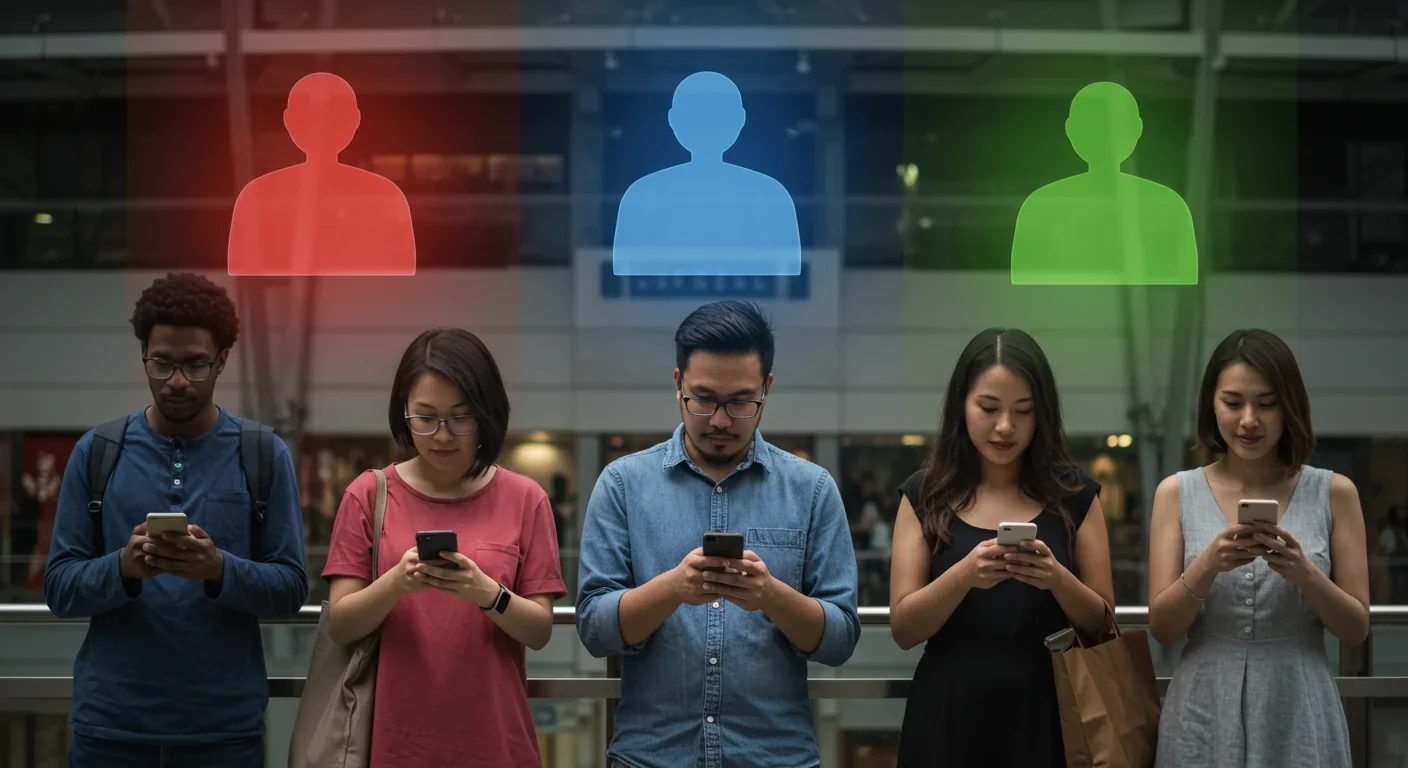Why Your Brain Sees Gods and Ghosts in Random Events

TL;DR: Ancient tribal instincts hardwired into our brains are now driving digital behavior—creating echo chambers, fueling political polarization, and intensifying conflicts in gaming and fandom communities. Understanding these evolutionary patterns can help individuals and platforms build healthier online spaces.

In the next decade, humanity will spend more time in digital communities than physical ones. Already, the average person scrolls through over 300 feet of social media content daily—that's the height of the Statue of Liberty. But beneath our tweets, likes, and shares lies something older than civilization itself: tribal instincts hardwired into our brains over hundreds of thousands of years. These ancient mechanisms, designed to help small groups of hunters survive on African savannas, now govern how billions interact online. And they're driving us into echo chambers, fueling political polarization, and turning fandoms into battlegrounds.
Our brains aren't built for the internet. For 95% of human history, we lived in groups of 50-150 people—small enough to know everyone personally. Evolutionary psychology reveals that survival depended on identifying who belonged to "us" versus "them." Those who quickly distinguished friend from foe, who bonded tightly with their group and distrusted outsiders, lived longer and had more children. Over millennia, these survival behaviors became automatic.
Fast-forward to today. Your brain still operates on that ancient software, but instead of scanning faces around a campfire, it's processing usernames, profile pictures, and comment threads. When someone with your political views gets ratio'd on Twitter, your amygdala—the brain's threat detector—fires up as if your actual tribe were under attack. When your gaming clan dominates a raid, your brain releases dopamine, the same neurochemical that rewarded your ancestors for successful hunts.
The problem? Digital platforms exploit these instincts at scale. Recent research from the University of Amsterdam found that echo chambers, attention inequality, and extreme voice amplification emerge automatically from basic platform architecture—even without recommendation algorithms. In simulations, researchers created a minimal social network with only posting, reposting, and following. No algorithmic manipulation. The result? Partisan echo chambers formed spontaneously, with an E-I index (a measure of group segregation) of -0.84, indicating extreme tribal sorting.
Social media platforms didn't create tribalism, but they've weaponized it. Algorithms are engineered to maximize engagement, and nothing drives engagement like tribal conflict. Studies show that Instagram's content-streaming algorithms lead to 15% higher affective polarization compared to Twitter's chronological feed. Among college-educated young voters, polarization scores on Instagram averaged 1.42 versus 1.17 on Twitter—a statistically significant gap that translates to millions of people viewing political opponents not just as wrong, but as threats.
Here's how it works: Every time you interact with content—a like, share, comment, or even a pause mid-scroll—algorithms learn what activates your tribal instincts. They identify your in-group markers (progressive, conservative, gamer, sports fan) and flood your feed with content that reinforces that identity. Simultaneously, they expose you to carefully curated examples of the out-group behaving badly. Not because the platform is politically motivated, but because moral outrage and in-group solidarity keep you scrolling.
Research into platform interventions reveals how difficult this is to fix. When researchers tested chronological feeds to reduce algorithmic manipulation, attention inequality decreased, but the "political prism" intensified—extreme users became more influential. Interventions that promoted high-quality bridging content strengthened some cross-partisan connections but also concentrated influence among fewer voices. Every fix created new problems because the architecture itself is tribal by design.
The numbers tell the story. On visual-first platforms like Instagram, 45% of young voters report that visual content primarily shapes their political views, compared to 28% on text-based platforms. Images and videos trigger faster emotional responses than text, making them more effective at activating tribal loyalty circuits before our rational brain can evaluate the content critically.

Political tribalism isn't new, but social media has transformed it from a bug into a feature. The 2024 U.S. election saw unprecedented turnout spikes among young voters after viral partisan content on TikTok. Not because young people suddenly became more civically engaged, but because tribal identity became entertainment.
Social media turns politics into team sports. You don't just disagree with the other side's policies—you despise their immorality, mock their intelligence, question their humanity. Affective polarization, the emotional hatred of opposing political groups, has skyrocketed in the algorithmic age. Studies tracking thousands of voters show that those who spend more time on engagement-driven platforms exhibit significantly higher levels of partisan hostility, even when controlling for pre-existing beliefs.
What makes digital political tribalism so potent is its performative nature. Historically, political identity was something you activated at the ballot box or dinner table. Now it's a 24/7 performance for an audience that rewards extreme loyalty. Posting a moderate take risks being attacked by your own tribe for insufficient purity. Meanwhile, inflammatory posts defending your side or attacking the opposition generate likes, shares, and that crucial dopamine hit.
The implications are chilling. When researchers examined echo chamber dynamics, they found participants regularly missed major news stories because their feeds had become so hyper-personalized. One case study followed a college student whose Instagram feed became so filtered that she was completely unaware of a widely covered national story—it simply never appeared in her corner of the internet. She lived in the same country, during the same week, but experienced a fundamentally different informational reality than her parents.
Gaming is where digital tribalism shows its double-edged nature. On one hand, gaming clans create genuine bonds. Players coordinate complex raids, develop specialized skills, and form friendships that extend into real life. These are tribes in the most functional sense—groups united by shared goals, mutual support, and earned status hierarchies.
But gaming tribalism has a dark side. Toxicity in online gaming is legendary, and it's driven by the same in-group/out-group dynamics that shaped our ancestors. Your clan is heroic and skilled; the opposing team are "noobs" who deserve mockery. When competition intensifies, so does tribal hatred. Racial slurs, death threats, and harassment campaigns emerge when tribal identity becomes wrapped up in digital reputation.
The gaming industry has struggled to address this because, paradoxically, tribal intensity drives engagement. Games that foster strong in-group identity keep players coming back. Developers want communities that are passionate but not toxic—a balance that's extremely difficult to strike when you're activating primal instincts.
Research on intergroup contact in online settings offers some hope. Studies of 2,254 participants found that gamers with more extensive offline intergroup contact—friendships with people from different backgrounds—showed higher empathy and more inclusive behavior online. They were significantly more likely to defend victims of bias-based harassment and less likely to participate in toxic pile-ons. High-quality offline contact translated to better online behavior by reducing intergroup anxiety and fostering dual-identity representations (seeing yourself as both a member of your clan and part of the broader gaming community).
Nowhere is digital tribalism more visible—or more bizarre to outsiders—than in fandom culture. Whether it's K-pop stans, Marvel vs. DC partisans, or rival anime fandoms, these communities exhibit all the hallmarks of ancient tribal behavior: fierce in-group loyalty, coordinated defense against out-group attacks, elaborate rituals (fan art, conventions), and strict policing of boundaries.
Studies of social media dynamics show how quickly tribal identity can form around shared aesthetics. When TikTok launched the Bold Glamour filter, it generated 220 million videos in its first week—a massive collective identity formation event. Users weren't just trying a filter; they were participating in a shared aesthetic experience that defined in-group membership.
Fandom tribalism becomes toxic when identity threat is perceived. Criticism of a beloved franchise feels like an attack on the tribe, triggering defensive aggression. Conversely, someone switching allegiance—say, admitting they now prefer a rival show—can be treated as betrayal worthy of harassment campaigns. These aren't rational responses to entertainment preferences; they're tribal instincts activated by content that has become central to digital identity.
What distinguishes healthy fandom from toxic tribalism? Mostly the ability to hold dual identities. Fans who see themselves as both members of their fandom and part of the broader fan community are less likely to engage in harassment. Those who make their fandom their entire identity exhibit more aggressive tribal behavior, especially when they perceive status threats.

Each notification delivers a hit of dopamine—the same neurotransmitter that fuels gambling addiction. But it's not random reinforcement; platforms have optimized the tribal reward system. Likes and shares tell you the tribe approves. Retweets amplify your status. Comment battles let you perform tribal loyalty for an audience.
Research into algorithmic manipulation reveals that platforms intentionally amplify content that worsens psychological vulnerabilities because it increases engagement. A leaked Facebook document showed Instagram's algorithms knowingly amplified body image content that harmed teenage girls, because vulnerable users' heightened engagement drove revenue. The same principle applies to tribal content: platforms know polarizing, tribal-activating content keeps you engaged, so they show you more.
The biological mechanism is straightforward. Your brain evolved to reward behaviors that increased survival and reproduction. Social belonging was crucial to survival, so your brain releases dopamine when the tribe validates you. Social media platforms exploit this by providing constant, quantified tribal validation. Every like is a micro-dose of belonging; every share is public proof of status.
Over time, you need bigger doses. The controversial take that got 50 likes last month needs to be more extreme to get 100 likes today. You're not consciously trying to radicalize your views; you're chasing the dopamine hit that comes from tribal approval, and the tribe rewards increasingly pure expressions of group identity.
The first step in navigating digital tribalism is recognizing when your tribal instincts are being activated. Ask yourself: Am I evaluating this information rationally, or am I reacting tribally?
Warning signs you're in tribal mode: Immediate emotional reactions to out-group content before fully understanding it; Pattern matching where you assume someone's full ideology from one position; Purity testing where minor disagreements feel like major betrayals; Dehumanizing language about out-groups (calling them stupid, evil, subhuman); Information filtering where you dismiss evidence that contradicts tribal narratives; Performance over persuasion where you're posting to impress your tribe, not convince others.
Psychological research shows that awareness alone isn't enough—you need active strategies. One evidence-based approach is practicing perspective-taking: Before reacting to out-group content, pause and articulate the strongest version of their argument. This cognitive exercise activates rational processing and temporarily overrides tribal reflexes.
Another powerful strategy is diversifying your offline relationships. Studies consistently show that high-quality intergroup contact—meaningful friendships with people from different political, cultural, or identity groups—significantly reduces online tribal behavior. It's harder to dehumanize categories of people when you know individuals from those groups personally.
For individuals, digital hygiene practices can reduce compulsive tribal engagement. Research shows that simple interventions work: time limits reduce compulsive scrolling; notification controls diminish the dopamine loop; curated feeds that prioritize authenticity over outrage shift your input. Following creators who model cross-partisan dialogue or who criticize their own tribe signals to algorithms that you want different content.
Media literacy programs that teach how algorithms exploit tribal instincts show measurable results. When young people learn that platforms profit from polarization, that feeds are curated to maximize engagement rather than truth, and that viral content is often the most emotionally manipulative, they become more resistant to tribal manipulation. Critical thinking about content sources and motivations turns passive scrolling into active evaluation.
For platforms, structural redesign is necessary but economically challenging. Research suggests that moving away from fully connected global networks toward more localized, group-centric architectures could reduce tribal dynamics. Imagine social platforms organized more like Discord servers—communities you explicitly join rather than algorithmic feeds that maximize engagement. This wouldn't eliminate tribalism, but it would reduce the scale and intensity by limiting global connectivity that amplifies extreme voices.
However, there's a fundamental tension: platforms profit from engagement, and tribal conflict drives engagement. Meaningful structural reform likely requires regulation, since platforms have little financial incentive to reduce the very dynamics that make them profitable.
AI moderation is both promising and concerning. Advanced language models can detect hate speech, identify coordinated harassment campaigns, and potentially intervene before tribal conflicts escalate. But they can also be gamed, and there's risk that moderation itself becomes tribalized—accusations of bias in what gets removed can intensify tribal grievances.
More hopefully, the next generation is developing new norms. Gen Z exhibits higher awareness of performative toxicity and is more likely to call out tribal pile-ons within their own groups. There's emerging cultural recognition that dunking on out-groups for likes is cringe, not cool—a crucial shift since peer norms within tribes can moderate or amplify toxic behavior.
The most important development is growing recognition that this isn't inevitable. Digital tribalism feels natural because it activates ancient instincts, but human behavior is remarkably flexible. We've successfully created norms against other instinctive behaviors (physical violence, in-person cruelty) when societies decide they're unacceptable. The same can happen online—but only if we acknowledge the problem and commit to changing both individual behavior and platform structures.
Within the next decade, how we navigate digital tribalism will fundamentally shape democracy, social cohesion, and individual mental health. The tribes we form online can be sources of belonging, support, and collective action for good. Or they can become echo chambers that radicalize us, polarize societies, and turn fellow citizens into enemies. The difference lies in understanding the instincts driving us—and choosing, consciously and collectively, to build something better than our worst tribal impulses.
Your brain evolved for a world that no longer exists, but you're not helpless. Every time you pause before reacting, question your tribal assumptions, or extend empathy across group boundaries, you're choosing your humanity over your hard-wiring. In the digital age, that choice matters more than ever.

Recent breakthroughs in fusion technology—including 351,000-gauss magnetic fields, AI-driven plasma diagnostics, and net energy gain at the National Ignition Facility—are transforming fusion propulsion from science fiction to engineering frontier. Scientists now have a realistic pathway to accelerate spacecraft to 10% of light speed, enabling a 43-year journey to Alpha Centauri. While challenges remain in miniaturization, neutron management, and sustained operation, the physics barriers have ...

Epigenetic clocks measure DNA methylation patterns to calculate biological age, which predicts disease risk up to 30 years before symptoms appear. Landmark studies show that accelerated epigenetic aging forecasts cardiovascular disease, diabetes, and neurodegeneration with remarkable accuracy. Lifestyle interventions—Mediterranean diet, structured exercise, quality sleep, stress management—can measurably reverse biological aging, reducing epigenetic age by 1-2 years within months. Commercial ...

Data centers consumed 415 terawatt-hours of electricity in 2024 and will nearly double that by 2030, driven by AI's insatiable energy appetite. Despite tech giants' renewable pledges, actual emissions are up to 662% higher than reported due to accounting loopholes. A digital pollution tax—similar to Europe's carbon border tariff—could finally force the industry to invest in efficiency technologies like liquid cooling, waste heat recovery, and time-matched renewable power, transforming volunta...

Humans are hardwired to see invisible agents—gods, ghosts, conspiracies—thanks to the Hyperactive Agency Detection Device (HADD), an evolutionary survival mechanism that favored false alarms over fatal misses. This cognitive bias, rooted in brain regions like the temporoparietal junction and medial prefrontal cortex, generates religious beliefs, animistic worldviews, and conspiracy theories across all cultures. Understanding HADD doesn't eliminate belief, but it helps us recognize when our pa...

The bombardier beetle has perfected a chemical defense system that human engineers are still trying to replicate: a two-chamber micro-combustion engine that mixes hydroquinone and hydrogen peroxide to create explosive 100°C sprays at up to 500 pulses per second, aimed with 270-degree precision. This tiny insect's biochemical marvel is inspiring revolutionary technologies in aerospace propulsion, pharmaceutical delivery, and fire suppression. By 2030, beetle-inspired systems could position sat...

The U.S. faces a catastrophic care worker shortage driven by poverty-level wages, overwhelming burnout, and systemic undervaluation. With 99% of nursing homes hiring and 9.7 million openings projected by 2034, the crisis threatens patient safety, family stability, and economic productivity. Evidence-based solutions—wage reforms, streamlined training, technology integration, and policy enforcement—exist and work, but require sustained political will and cultural recognition that caregiving is ...

Every major AI model was trained on copyrighted text scraped without permission, triggering billion-dollar lawsuits and forcing a reckoning between innovation and creator rights. The future depends on finding balance between transformative AI development and fair compensation for the people whose work fuels it.